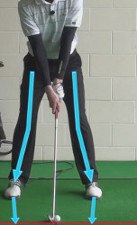
Alignment is a golf term that refers to the positioning of a golfer's body and club in relation to the target line. It is a fundamental aspect of the golf setup and plays a crucial role in aiming the shot accurately.
Proper alignment ensures that the golfer's body and club are positioned parallel to the intended target line. The target line is an imaginary line that extends from the ball to the desired target, such as the flagstick or a specific spot on the fairway.
When aligning for a shot, golfers typically follow these steps:
- Select a target: Golfers visually identify the target they want to aim for, such as a specific point in the fairway or the flagstick on the green.
- Aim the clubface: The golfer positions the clubface so that it points directly at the target. This is typically done by aligning a spot on the clubface, such as the leading edge or the club's logo, with the target.
- Align the body: The golfer aligns their body parallel to the target line. This means that the feet, knees, hips, and shoulders are all positioned parallel to the target line. For a right-handed golfer, the body alignment will be slightly left of the target line, while for a left-handed golfer, it will be slightly right of the target line.
- Check alignment: Golfers often use visual aids such as alignment rods or alignment sticks placed on the ground to help ensure proper alignment. They can also rely on natural reference points on the course, such as tee markers or divots, to confirm their alignment.
By maintaining proper alignment, golfers increase their chances of hitting the ball toward the intended target, resulting in more accurate shots. It is an essential skill to develop consistency and improve overall performance in golf.
Alignment: The manner and direction in which a player aims to hit a shot, based on lines formed by the feet, hips, shoulders and clubface.




